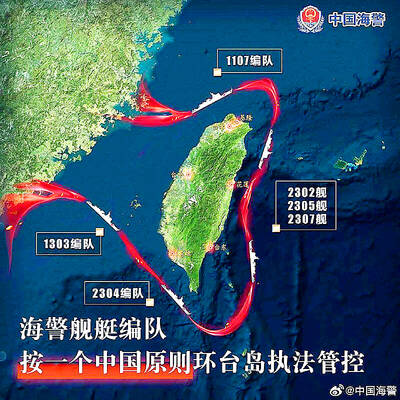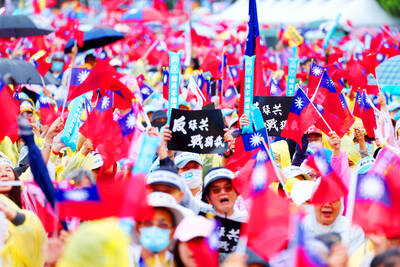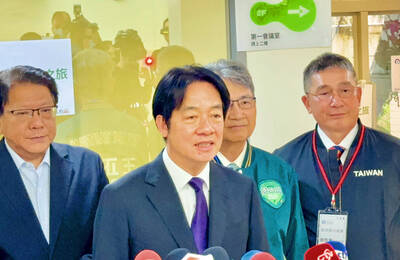Surprised scientists say that typhoons that hit Taiwan unleash long, slow earthquakes, a phenomenon that may save it from more devastating temblors.
Seismologists installed movement sensors in boreholes at depths of 200m to 270m in eastern Taiwan, monitoring a spot where two plates, the Philippine Sea Plate and the Eurasian plate, bump and jostle in an oblique, dipping fault.
Over five years, researchers saw a remarkable correlation between tropical storms and “slow” earthquakes, a seismic beast first identified three decades ago.
Slow quakes entail a slippage in the fault that unfolds progressively over hours or days, rather than a sudden, violent release of the kind that destroys buildings and lives.
The sensors noted 20 such slow earthquakes, 11 of which coincided with typhoons, during the study period.
The 11 quakes were all stronger and characterized by more complex seismic waveforms than other “slow” events.
“These data are unequivocal in identifying typhoons as triggers of these slow quakes. The probability that they coincide by chance is small,” said coauthor Alan Linde of the Carnegie Institution for Science in Washington.
A typhoon causes a fall in atmospheric pressure — and the researchers suggest that this in turn reduces pressure on the land over the fault.
As a result, one side of the fault lifts slightly, causing the pressure that has been building up inside to be released.
“This fault [in Taiwan] experiences more or less constant strain and stress buildup,” Linde said in a press release.
“If it's close to failure, the small perturbation due to the low pressure of the typhoon can push it over the failure limit. If there is no typhoon, stress will continue to accumulate until it fails without the need for a trigger,” he said.
The typhoon does not work as a seismic trigger on faults that lie on the seabed because water moves into the area, dampening out any difference in pressure, the authors theorize.
Often considered a curse, typhoons — for Taiwan — could in fact could be a blessing.
A storm could act as a pressure valve, preventing strain from building up to the point where the fault ruptures devastatingly.
The Nankai Trough in southwestern Japan also lies on the convergence of the Philippine Sea and Eurasian plates.
The plates are converging at a rate of about 4cm per year, which is about half that of the activity in Taiwan.
In theory, Taiwan should be more vulnerable than the Nankai Trough because of the greater slippage, but the record shows that it has had no great earthquakes and relatively few large quakes, Linde said.
By comparision, the Nankai Trough is capable of unleashing a true monster, a magnitude-8 earthquake, every 100 to 150 years.
The paper, published in the British journal Nature, was written by a team led by Liu Chi-ching (劉啟清) of the Institute for Earth Sciences at Academic Sinica.

Taiwan would benefit from more integrated military strategies and deployments if the US and its allies treat the East China Sea, the Taiwan Strait and the South China Sea as a “single theater of operations,” a Taiwanese military expert said yesterday. Shen Ming-shih (沈明室), a researcher at the Institute for National Defense and Security Research, said he made the assessment after two Japanese military experts warned of emerging threats from China based on a drill conducted this month by the Chinese People’s Liberation Army’s (PLA) Eastern Theater Command. Japan Institute for National Fundamentals researcher Maki Nakagawa said the drill differed from the

‘WORSE THAN COMMUNISTS’: President William Lai has cracked down on his political enemies and has attempted to exterminate all opposition forces, the chairman said The legislature would motion for a presidential recall after May 20, Chinese Nationalist Party (KMT) Chairman Eric Chu (朱立倫) said yesterday at a protest themed “against green communists and dictatorship” in Taipei. Taiwan is supposed to be a peaceful homeland where people are united, but President William Lai (賴清德) has been polarizing and tearing apart society since his inauguration, Chu said. Lai must show his commitment to his job, otherwise a referendum could be initiated to recall him, he said. Democracy means the rule of the people, not the rule of the Democratic Progressive Party (DPP), but Lai has failed to fulfill his

OFF-TARGET: More than 30,000 participants were expected to take part in the Games next month, but only 6,550 foreign and 19,400 Taiwanese athletes have registered Taipei city councilors yesterday blasted the organizers of next month’s World Masters Games over sudden timetable and venue changes, which they said have caused thousands of participants to back out of the international sporting event, among other organizational issues. They also cited visa delays and political interference by China as reasons many foreign athletes are requesting refunds for the event, to be held from May 17 to 30. Jointly organized by the Taipei and New Taipei City governments, the games have been rocked by numerous controversies since preparations began in 2020. Taipei City Councilor Lin Yen-feng (林延鳳) said yesterday that new measures by

A rally held by opposition parties yesterday demonstrates that Taiwan is a democratic country, President William Lai (賴清德) said yesterday, adding that if opposition parties really want to fight dictatorship, they should fight it on Tiananmen Square in Beijing. The Chinese Nationalist Party (KMT) held a protest with the theme “against green communists and dictatorship,” and was joined by the Taiwan People’s Party. Lai said the opposition parties are against what they called the “green communists,” but do not fight against the “Chinese communists,” adding that if they really want to fight dictatorship, they should go to the right place and face